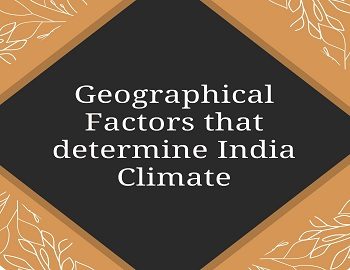Geographical Factors that determine India Climate:
The Himalayas- The Himalayas form the northern frontiers of India. They act as a climatic divide between the Indian Sub-Continent and the rest of Asia. The mountains protect India from the cold winds of Central Asia in winter. They also create barriers for the South-west Monsoon winds and force them to shed moisture in the country during summer. The whole of India gets rainfall for this reason.
The Coast Line- India has a large coast line. The Peninsular situation has helped it to enjoy an equable climate in southern India. Going towards the north, the effect of the maritime climate goes on reducing. North India experiences a climate altogether different from Peninsular India. Its climate is continental which has marked seasonal variations. We call this the extreme climate.
Relief- Variations in relief of the country directly affect her climate. Relief features influence the distribution of both temperature and precipitation alike. Low temperatures are found in mountain regions. They are comparatively higher in plains. The distribution of rainfall also depends upon relief features. Western slopes of the Western Ghats get heavy rainfall while their eastern slopes have a marked decrease in the amount of rainfall. Mahabaleshwar receives 625 cms. of rainfall while Pune, only a few kilometres away receives only 60 cms. Similarly, the north-eastern mountains region receives heavy rainfall. From east to west it goes on decreasing. Calcutta gets 120 cms. of annual rainfall while Delhi only 56 cms.
The Western Depressions- The western depressions from over the Mediterranean Sea enter India through Iran, Afghanistan and Pakistan during winter. They cause rainfall in Jammu-Kashmir, Punjab, Haryana, Western Uttar Pradesh and the Himalayan foothills. The northern mountains receive precipitation by these depressions in the form of snowfall. Sometimes plains of the country experience hail-stones mixed with rainfall. The depressions sometimes turn into a cold wave. They reduce the temperature considerably. Hundreds of poor and ill-clad people die in these cold waves.
Low pressure region of the Central Asia and Tibet- During summer low pressure region is formed over Middle East countries, Central Asia and Tibet. In winter the low pressure region turns into high pressure region. It obstructs occurrence of rainfall in India in winter. This is the reason that most parts of the country go dry during winter.
Jet Stream- Strong winds currents blow horizontally in the upper layer of the Troposphere. These strong wind currents are called jet streams. Jet stream affects the climate to a great extent. It plays an important role in getting the western depressions to enter India and causes winter rains in the western parts of the country.
Southern Oscillation- There is a great relationship between the meteorological changes over the Pacific Ocean and the Indian Ocean. When pressure is high over the sub-tropical portion of the Pacific Ocean, there is low pressure over the southern portion of the Indian Ocean. On the contrary, when the tropical Pacific Ocean has a low-pressure region, it tends to be high pressure on the southern Indian Ocean. This results in the shifting of winds across the Equator in different seasons. This phenomenon is known as Southern Oscillation. The shifting of winds across the Equator and their intensity affects the Monsoon in a big way.









Comments (No)